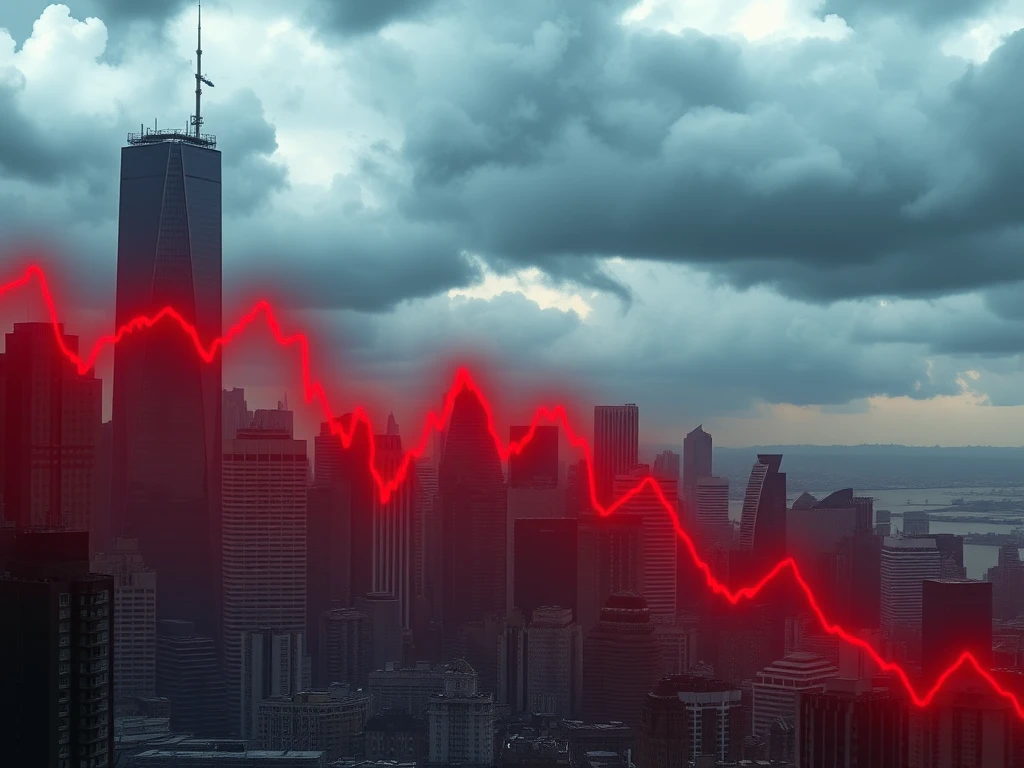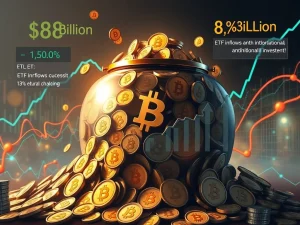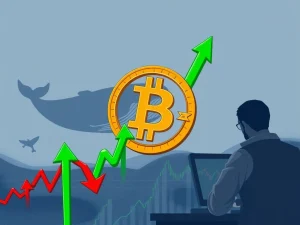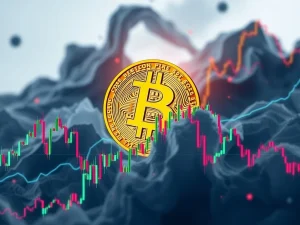Urgent Bitcoin Crash Alert? 5 Things Crypto Traders Need to Know Now

Is the crypto market bracing for another seismic shock? Bitcoin is flashing warning signs, evoking chilling memories of past market collapses. As trade tariff tensions escalate and a bearish ‘death cross’ looms, are we staring down the barrel of a ‘Black Monday 2.0’ scenario? This week is pivotal for Bitcoin, and here are five crucial things every crypto trader and investor needs to understand.
1. Bitcoin ‘Death Cross’ Signals Potential Price Drop
A dreaded technical pattern known as the ‘death cross‘ has emerged on Bitcoin’s daily chart. This bearish signal occurs when the 50-day simple moving average (SMA) dips below the 200-day SMA, historically indicating potential further price declines. For Bitcoin, this ‘death cross‘ arrives at a particularly precarious moment, amplifying existing market anxieties.
As Material Indicators highlighted, this technical formation puts Bitcoin at a ‘critical macro support test.’ The momentum behind this ‘death cross‘ cannot be ignored, suggesting increased downside pressure on BTC in the short term. Keep a close watch on how Bitcoin reacts to this significant technical event.
2. Is a Bitcoin Crash to 2021 Levels Imminent?
The current market conditions are pushing Bitcoin into uncharted territory, revisiting price levels not seen since 2021. After breaching the $75,000 mark, key support levels from the previous bull run, such as $69,000, are now back in play. This rapid descent has caught many off guard, prompting questions about the depth of this correction and the potential for a more severe Bitcoin crash.
Analyst Kevin Svenson points out that Bitcoin is at a ‘last chance’ moment to maintain its macro uptrend. Losing further support could indeed open the door for a deeper Bitcoin crash, potentially erasing a significant portion of recent gains. The psychological impact of revisiting 2021 prices could trigger further panic selling.
3. Trade Tariffs Trigger Market Mayhem and Bitcoin’s Response
The dominant force casting a shadow over global markets, including crypto, is the escalating US trade tariffs. These tariffs, confirmed by Commerce Secretary Howard Lutnick, are not just a US issue; they are reverberating across global economies, impacting stock markets and risk assets like Bitcoin. The anticipated April 9th tariff release is adding fuel to the fire, intensifying market uncertainty.
The impact of these trade tariffs is multifaceted:
- Stock Market Downturn: Traditional financial markets are reacting sharply to tariff announcements, creating a risk-off environment.
- Contagion Effect: Bitcoin, despite aspirations of being an uncorrelated asset, is showing correlation with traditional market downturns.
- Inflationary Pressures: Tariffs could lead to unexpected price increases, further complicating the economic outlook.
The trade tariffs are not just an economic policy; they are a major catalyst driving current market volatility and impacting Bitcoin’s price trajectory.
4. Emergency Rate Cut on the Horizon? Market Bets on Fed Action
Amidst the tariff-induced turmoil, market participants are increasingly betting on a swift response from the Federal Reserve. The possibility of an ’emergency rate cut‘ is gaining traction as investors anticipate the Fed will need to cushion the economic blow from trade tariffs. The CME Group’s FedWatch Tool now indicates a growing consensus for a 0.25% rate cut as early as May.
Anthony Pompliano suggests the Fed might need to act even sooner with an emergency rate cut. The logic is that lowering interest rates could inject liquidity into the market and potentially offset some of the negative impacts of the tariffs. However, an emergency rate cut also signals significant economic distress, which can have mixed effects on market sentiment.
5. Black Monday 2.0 or COVID Crash Repeat? Fear Grips the Market
The current market sell-off is drawing comparisons to historical crashes, most notably ‘Black Monday‘ of 1987 and the COVID-19 induced market crash of March 2020. The speed and severity of the recent market downturn have amplified these fears, leading to talk of ‘Black Monday 2.0‘.
Michaël van de Poppe believes crypto’s ‘Black Monday‘ moment might already be underway, predicting a volatile period with potential Bitcoin lows around $70,000. The Kobeissi Letter points to circuit breakers in Asian stock markets, reminiscent of the March 2020 crash, indicating widespread panic and a ‘rush to the exit’ among investors. While history doesn’t always repeat itself, these comparisons highlight the extreme fear currently dominating market sentiment.
Investor Sentiment Hits Rock Bottom
Adding to the bearish outlook, the traditional market Fear & Greed Index has plummeted to record lows, even surpassing the levels seen during the COVID crash and the FTX collapse. While the Crypto Fear & Greed Index is slightly higher, it still reflects a state of fear. This extreme bearish sentiment can be a double-edged sword. On one hand, it signals intense selling pressure. On the other hand, as Capriole Investments suggests, it could also present a ‘local opportunity’ to ‘buy the dip’ for those with a longer-term perspective.
Final Thoughts: Navigating the Bitcoin Storm
This week presents a critical juncture for Bitcoin and the broader crypto market. The confluence of a ‘death cross‘, trade tariffs, Bitcoin crash concerns, and ‘Black Monday‘ comparisons creates a volatile and uncertain environment. While some see opportunity in the fear, caution and diligent risk management are paramount. Keep a close eye on price action, monitor macroeconomic developments, and be prepared for potential further turbulence in the days ahead. The possibility of an emergency rate cut adds another layer of complexity, making this week one to watch with heightened vigilance.
Disclaimer: This article is for informational purposes only and does not constitute financial advice. Trading and investing in cryptocurrencies involves significant risk. Conduct your own research and consult with a financial advisor before making any investment decisions.









